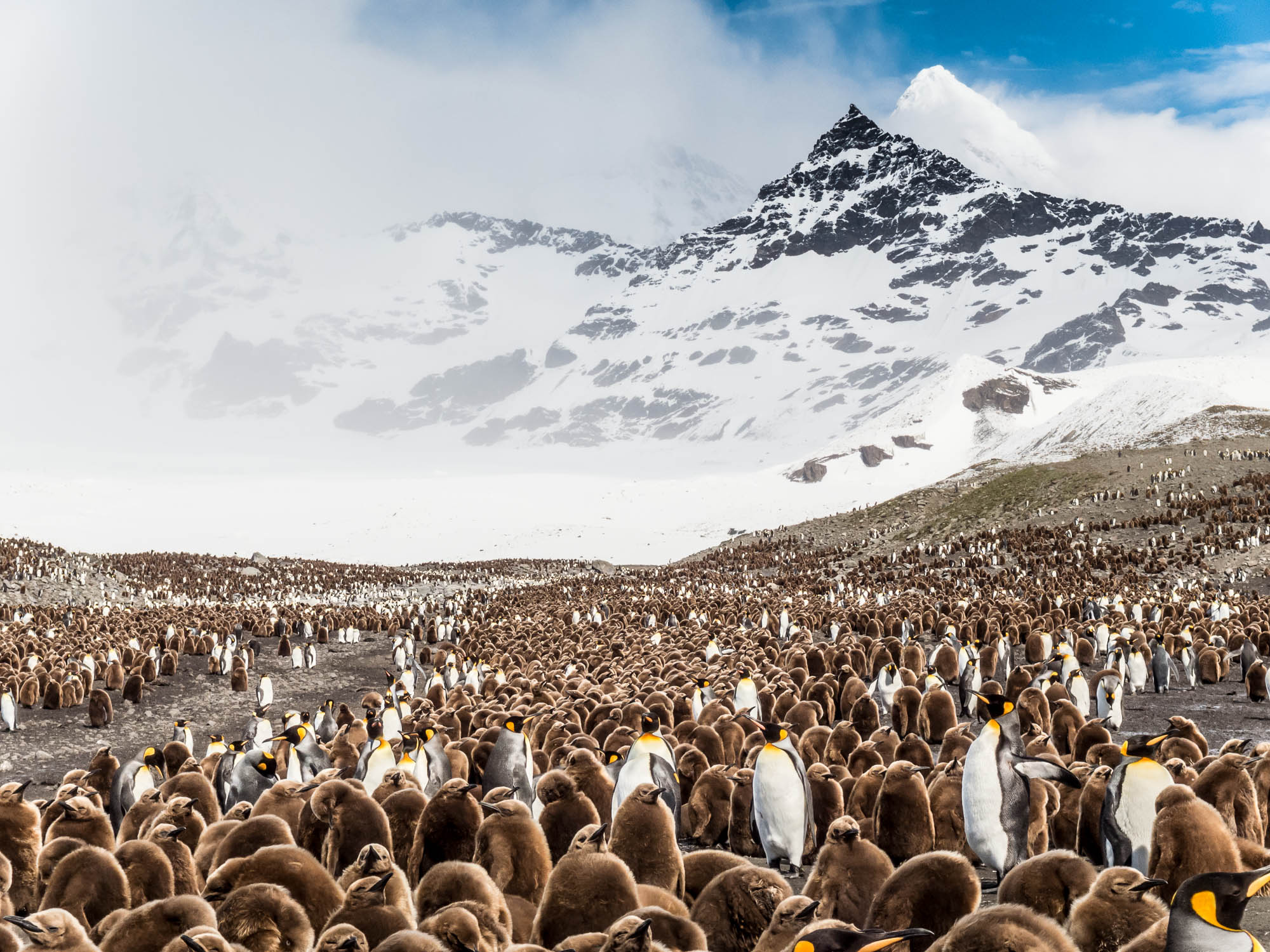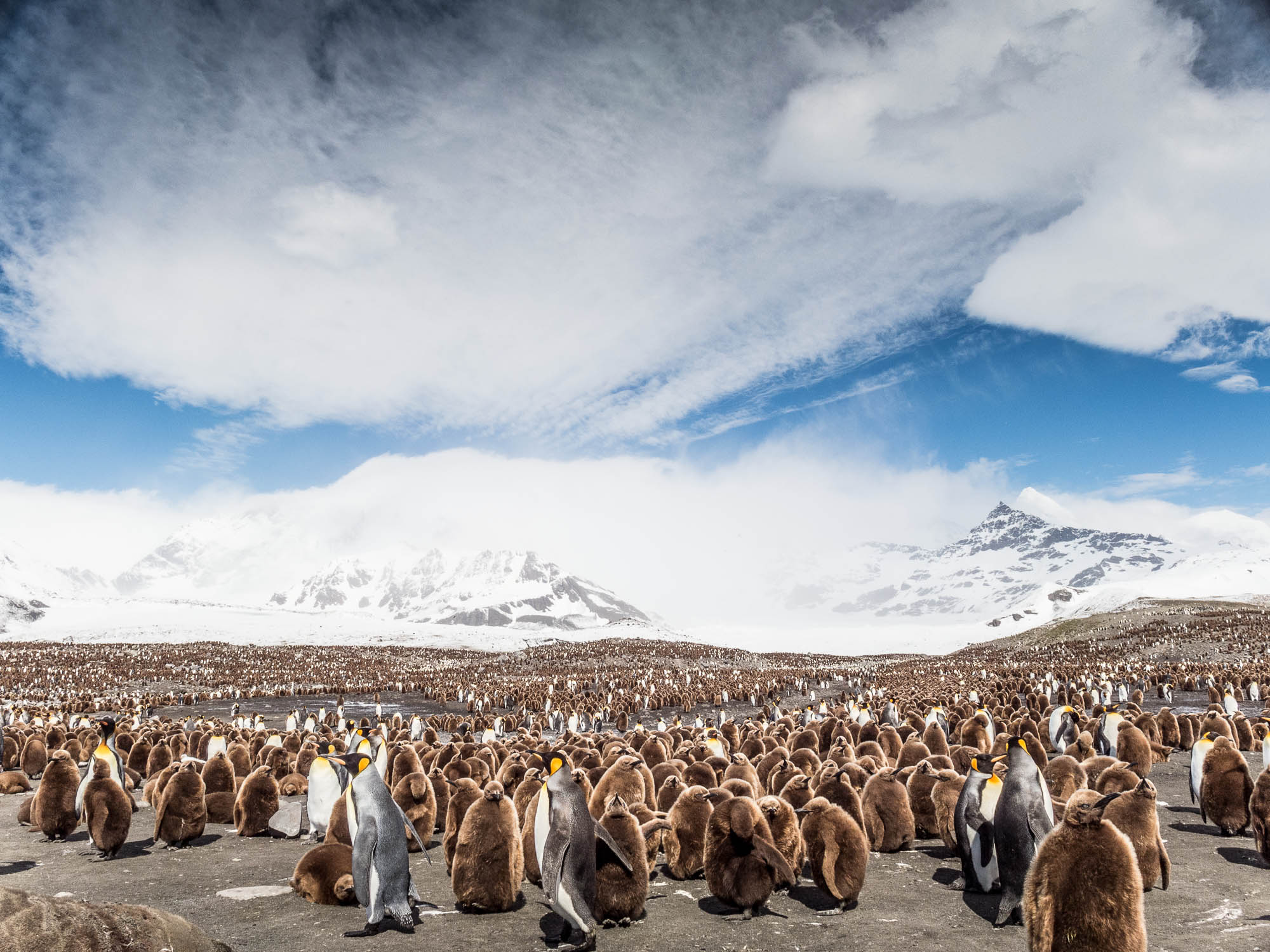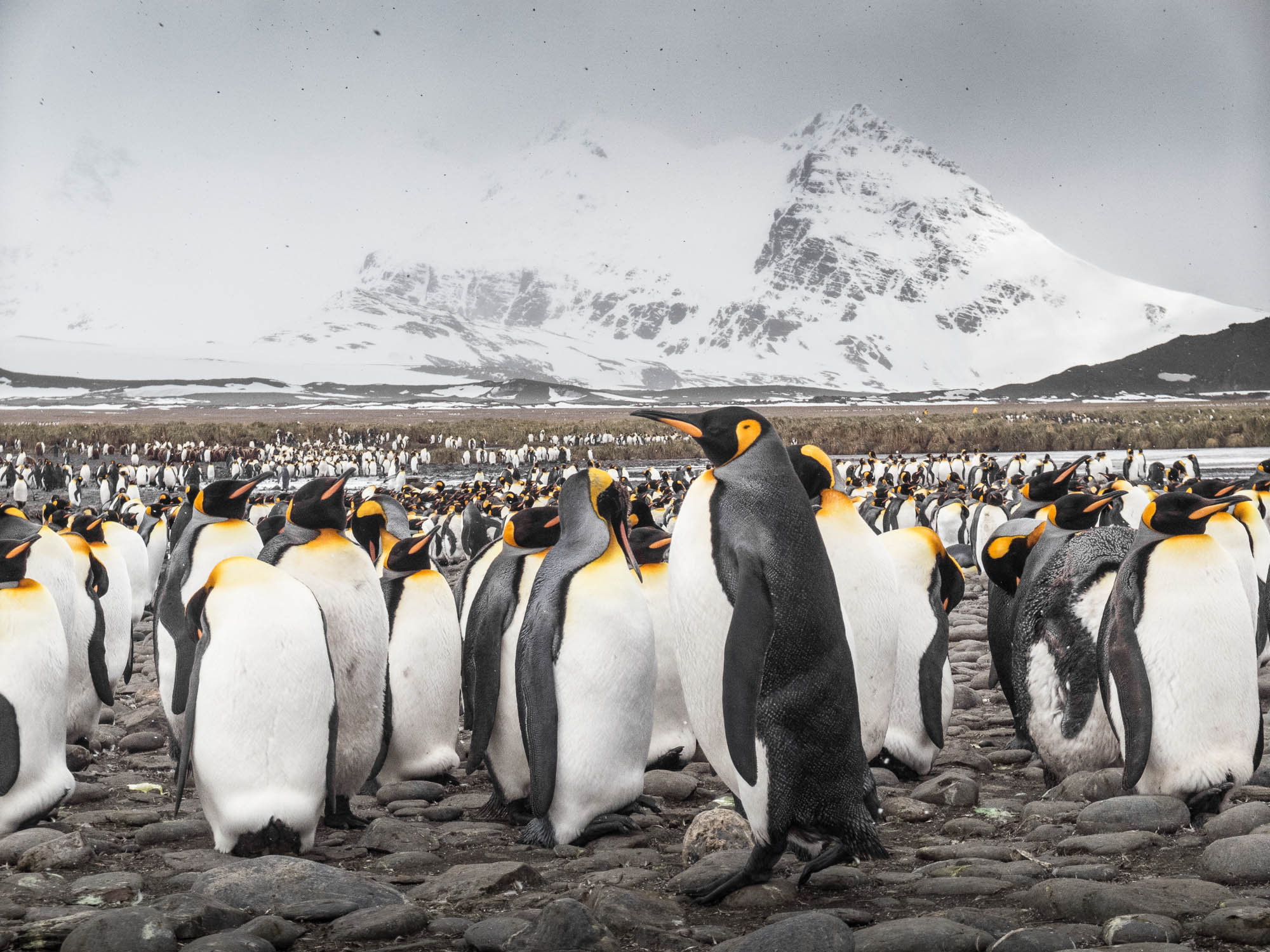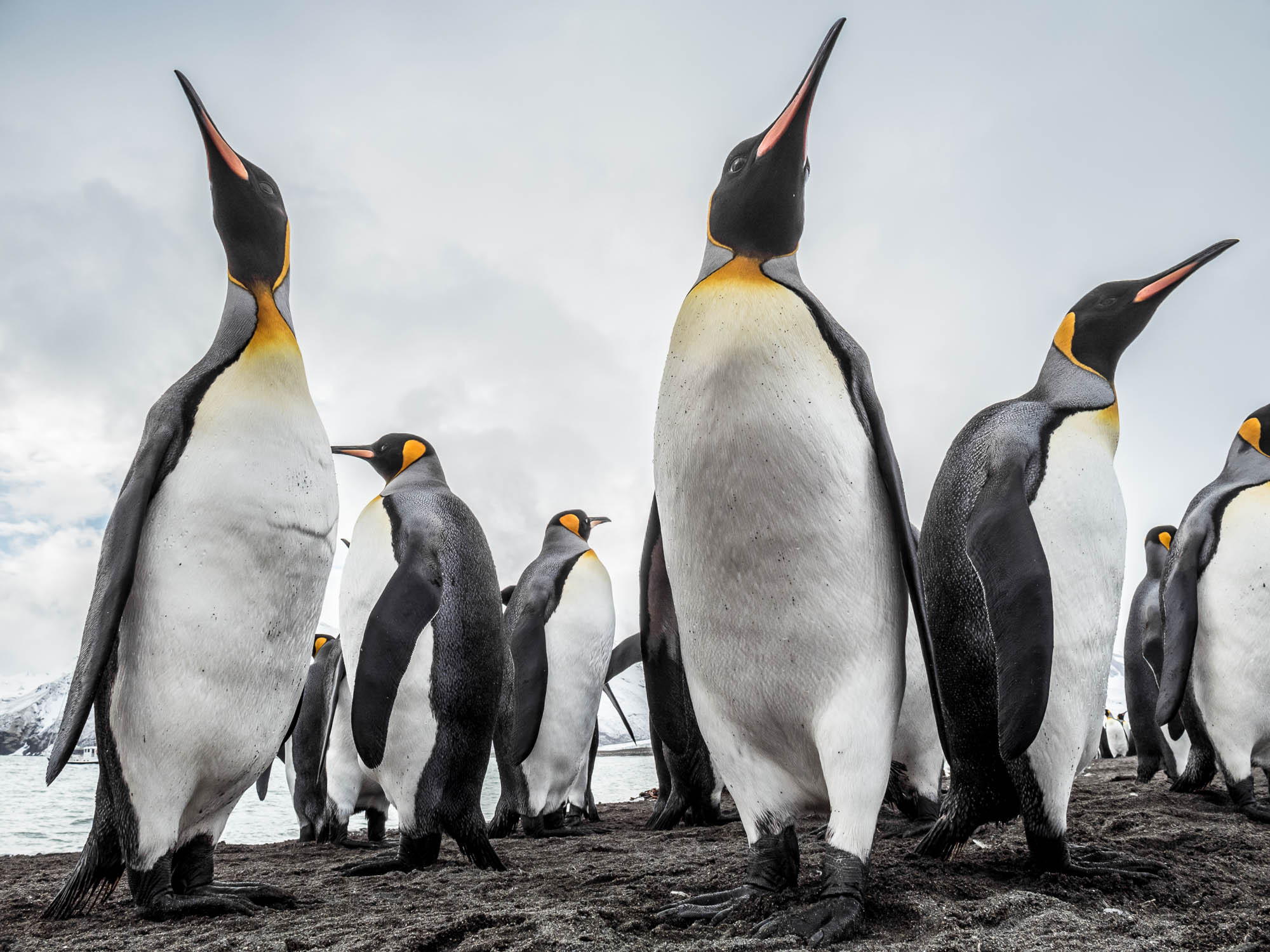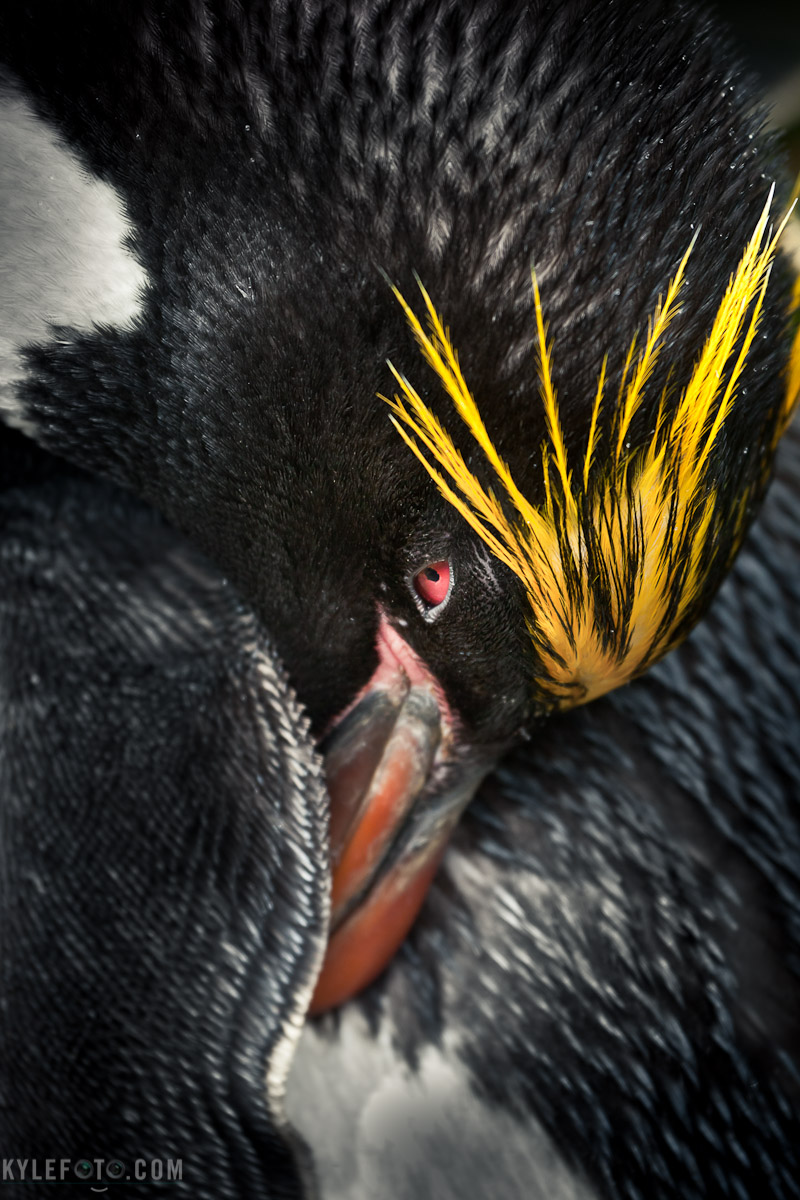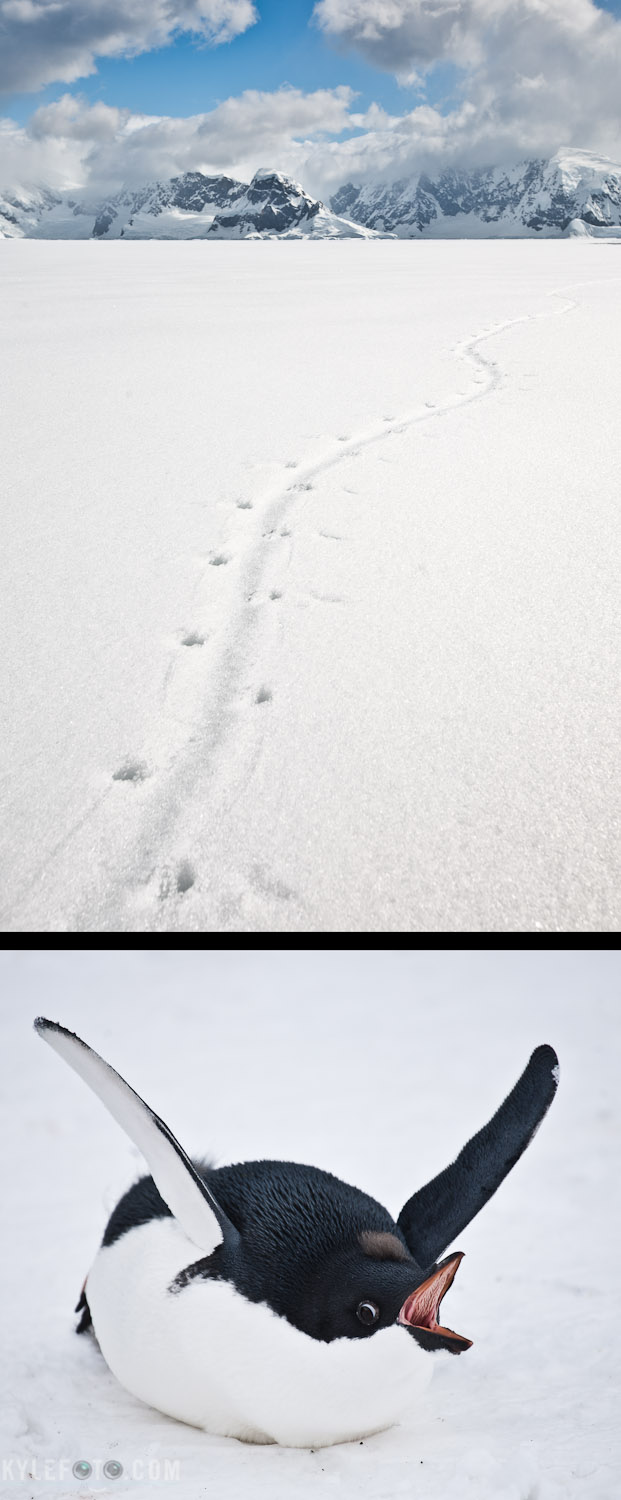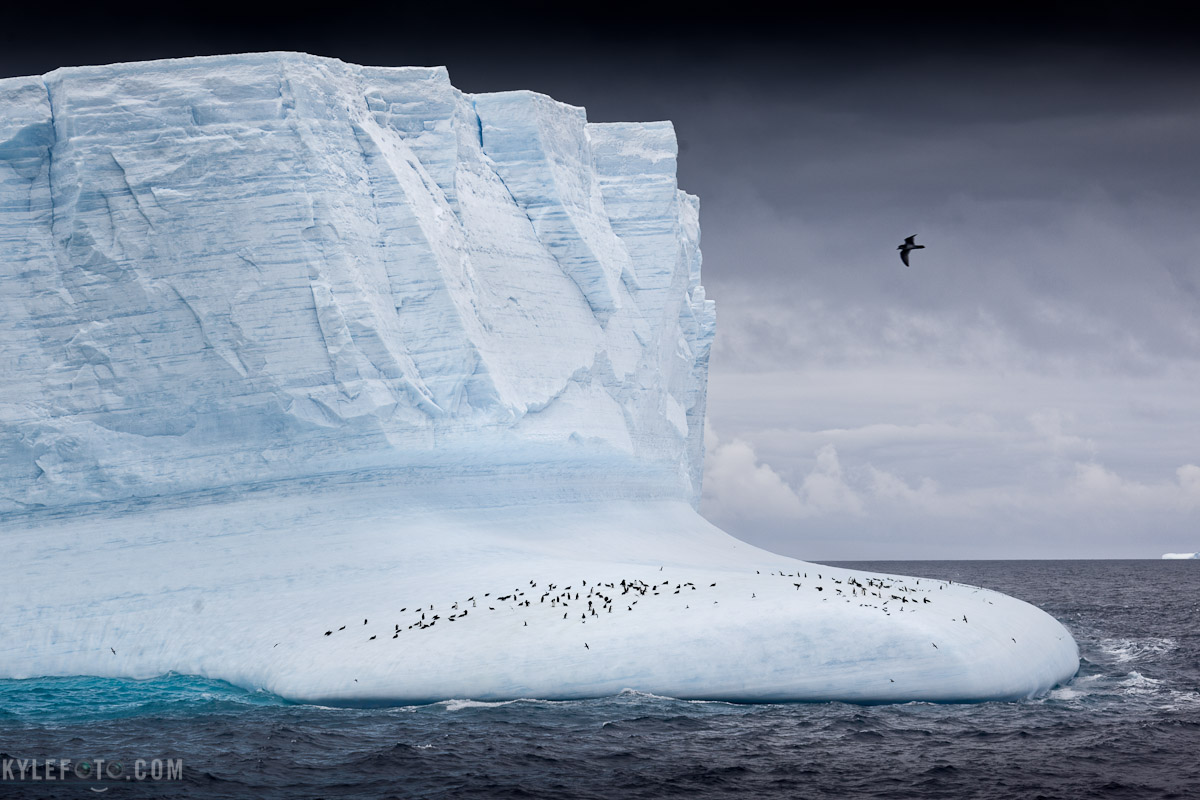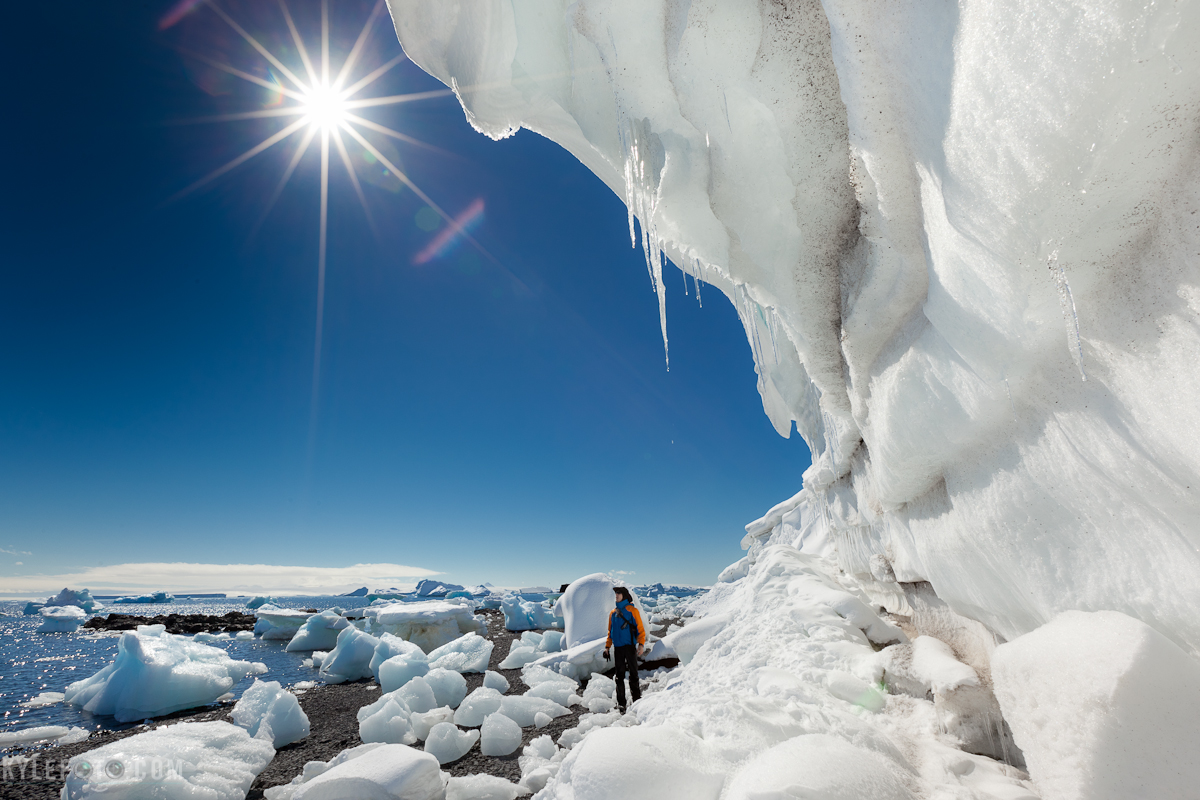Antarctica
Antarctica
Antarctica
Ice and Sky
Antarctica The ice whips off the continental glaciers of antarctica, carrying with these torrential winds a fine dusting of ice crystals. These give the edges of the glacier an etherial feel, looking like a continental sized thermos of liquid nitrogen as condensed air flows from the edges.
Photographic details: A lot of people think it’s wrong to point their camera directly into the sun, I say keep your lens clean and shoot directly into it! The sun was just above the top of the image and the way the light lit the edges of the glacier and fine ice crystals was perfect. If you think something will be difficult to photograph, give it a try, the result may surprise you.
1/125s f/9.0 ISO100 35mm
The Perfect Exposure, Lyubov Orlova
Antarctica The Lyubov Orlova, this ship named after a famous russian star had it’s hey day, but it certainly isn’t now. I had taken many voyages on this bucket of rust and I’ve decided to post about it given it’s intimate history with the Antarctic. It has recently been bought for $275,000 in the hopes that it’s worth more than that in scrap metal.
My first impression venturing on board was doing life boat drills noticing to my horror that the life boats were not covered. Knowing if this ship ever sunk in Antarctic waters during a strong storm I would be floating but I would still be exposed. I remember formulating a plan to jump inside the much more appropriate inflatable covered life rafts with the russian crew where I would certainly be warmer.
Running my hands along the outside of the of the ship was a very textural affair, 30 years of paint caked on the hull seemed to weigh the ship down and crust off with a slight touch. The skin of the hull was sunken in except for where there were reenforcing bulk heads, sticking out like the exposed ribs of a starving horse. I imagined how many bumps and scrapes this ship had to experience to have so many panels dented and bent inwards and had to stop thinking of such things as I listened to the creaks and groans echoing through the ship at night if I wanted any sleep.
Despite her crotchety demeanour, the Lyubov Orlova’s hallways echoed with the sound of joy and laughter. Filled with the gleeful faces of passengers who just saw their first humpback whale surfacing beside an iceberg, giggles of the people in the bar reminiscing over the farts and sneezes of the elephant seals. If the outer decks could speak they would talk of the feeling of awe so many thousands of people felt as they saw their first iceberg and the grand view of antarctica opened up before them. Who knows what this ship has seen, I’m sure if the cabins could speak they might talk of many nights of love an passion.
After Raw Processing
Before Raw processing:
Photographic Details: With this shot I got “the perfect exposure” not so bright that the highlights are overexposed, not too dark that there are no details in the shadows, this is what one would consider a perfect exposure and all without HDR. Yet the original image looks like garbage, it’s flat, has no contrast and the sky looks grey. I was there, and that sky was not grey! That old ship wasn’t bland dark blue it was royal blue and bright orange, and despite it’s age the fresh coat of white paint was stark white.
Thank goodness I shot this one in RAW.
Of course in lightroom I increased the contrast and selectively brightened the ship with the brush tool set to exposure. With about 4 adjustments I’ve gotten a wildly superior image that is far more like being there than the original image expresses.
I was also experimenting with a wide angle fisheye lens, I really loved the extreme distortion but quite frankly it’s a little too much and quite gimmicky. I do like how the distortion leads your eye to the centre of the image, and how it adds a sense of drama, but use this lens too much and you might bore your audience, use sparingly.
See the original shot before processing at www.kylefoto.com to compare!
For #wideanglewednesday curated by +Asif Patel
Digital fisheye Antarctic Vista
Antarctica The views that welcome you when you first arrive along the Antarctic continent is quite the sight to behold. Being surrounded by these tall icy figures rising out of the ocean feels like the mountains are hugging you, and despite the cool the antarctic air I always feel warm and fuzzy. This is one of the images I used to promote my Polar Worlds show.
Click Image for larger version
Photographic Details: Fisheye photos are cool but to use one regularly would be somewhat disorientating. The original shot had a flat horizon but I wanted something a little more dynamic. So instead of going out to get a fisheye I thought I would make the effect myself, turns out it’s possible in photoshop in about 7 clicks of the mouse!
Photoshop:
Open the image and double click your layer to rename it, you need to rename it to anything but “background” to unlock it for editing.
[image size="medium" autoHeight="true"]http://www.kylefoto.com/wp-content/uploads/2011/11/layers.jpg[/image]
Then go to Edit>Transform>Warp
[image lightbox="true" size="medium" autoHeight="true"]http://www.kylefoto.com/wp-content/uploads/2011/11/edittransform.jpg[/image]
Click on the middle of the image and drag your mouse down to begin warping, try it in other ways to get different results.
[image lightbox="true" size="large" autoHeight="true"]http://www.kylefoto.com/wp-content/uploads/2011/11/warp1.jpg[/image]
[image lightbox="true" size="large" autoHeight="true"]http://www.kylefoto.com/wp-content/uploads/2011/11/warp2.jpg[/image]
When you are finished, press enter, and you are done!
Canon EOS 5D, 1/100s f/5.0 ISO50 35mm 16-35mm f2.8 L lens.
If you like this, please share. And if you try this technique, post it in the comments and share, let’s see what you can do!
[button link="http://kylefoto.smugmug.com/Antarctica/Antarctic-Worlds/19589737_M4DwLg#1578973757_dfpPFgL" color="blue"]Order print through Smugmug[/button]
They called him Macaroni... Penguin
South Georgia, Antarctica Macaroni: A term used in the mid 18th century to describe an unusually fashionable man who cared very much about his appearance with a flamboyant flair. Previous terms such as fashion-monger, ninny and fop were also used for someone overly concerned about their clothing. The Macaroni fashion was a precursor to the “dandies” which were the early 19th century metrosexuals.

Hence once the unusually vibrant crest of the Macaroni penguin was first observed they were given this name. These penguins were sitting on their nest, carefully keeping an eye on us while they tucked their necks in to conserve warmth and rest. Macaroni penguins lay two eggs during the mating season but often toss the first one out to make way for the second. The mother and father will share their responsibility over the egg as it incubates for a month, and raises the chick over another month. In this time the parents may fast for up to 42 days losing 40% of their body weight. Talk about dedicated parents.
Photographic details: I had to be very careful approaching these penguins. Believe it or not there is tall tussok grass growing here, it’s easy to accidentally step on a macaroni nest in a place like this. As we crouched down to their level this guy would keep an eye on me but that was the greatest reaction this bird would give me, and I respected their space as I waited for them to take a brief glance at me. After spending time with these fastidious penguins, I realize they only live up to their namesake in appearance. Canon 5DMarkII ISO400, 400mm, f7,1 1/320sec
Ghosts of South Georgia
Gold Harbour, South Georgia, Antarctica The edge of the harbour that is home to 25,000 breeding pairs of king penguins. The sea is the key to life here, where penguins can bring krill and fish back to the mouths of their hungry chicks. This place was called “Gold Harbour” by whalers given it is full of large elephant seals and numerous king penguins. They were easy to capture and kill to be boiled for their blubber and oil, which was worth a lot of money in this last haven for whalers. In addition a lot of pyrite or “fools gold” had been found by Filchner’s German Antarctic Expedition in 1911.
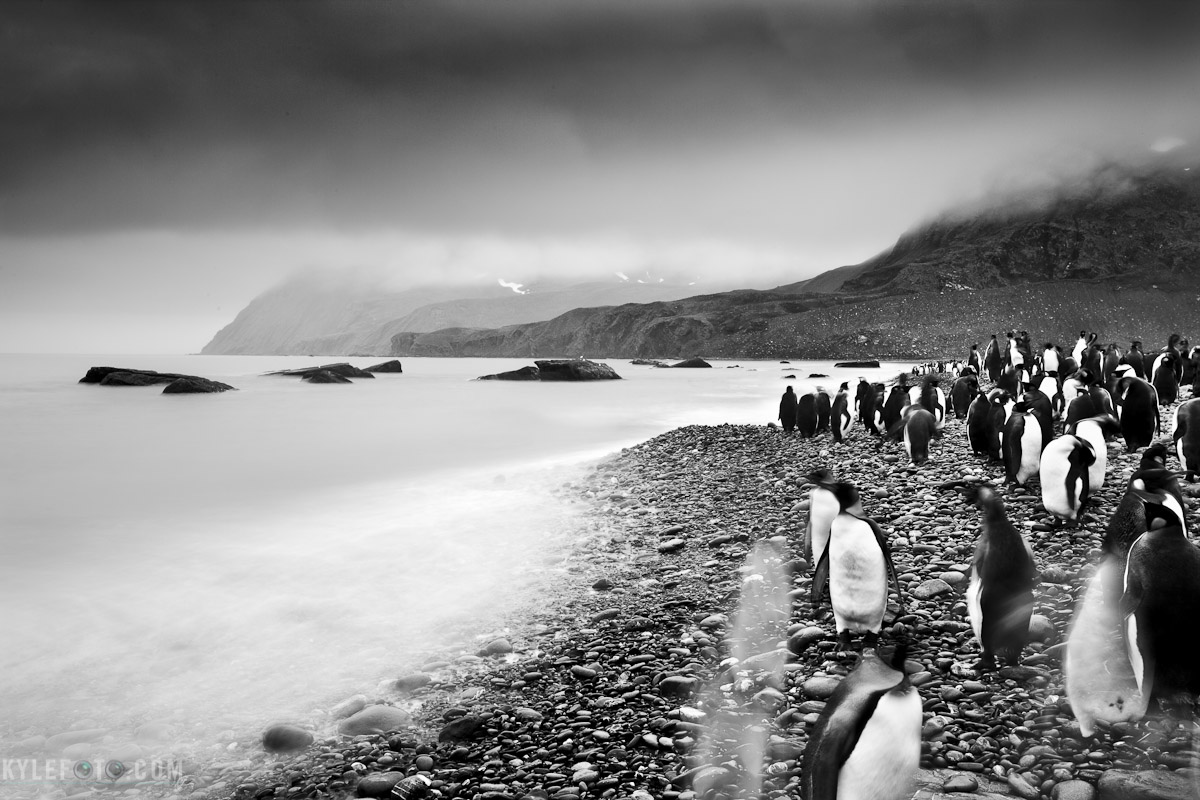
Photographic details: I wanted to create a ghostly image with a lot of mood and drama, the long exposure technique works very well for this. With the extreme brightness of the mid day sun filtering through the overcast sun the longest exposure I could get was four seconds. In order to get the long exposure I wanted I had to mash 20 four second exposure images together to create a total of 80 seconds.
ISO50, f18, with a 5 stop ND filter, 20 4 second exposures combined into 80 seconds If you like this, do me a favour and please share!
Penguin sledding
Wilhelmina Bay, Antarctica, Christmas Day Imagine yourself laying on your belly in the snow with your arms and feet splayed outwards. Using your belly as a sled you paddle your arms and legs to propel yourself forwards, if you do this, you are now a penguin.
Penguins will lay down on their belly and extend their front flippers while gently kicking with their toes, almost like paddling. Their smooth bellies mostly free of friction allow them to slide with relative ease. I have seen them slide down hills with glee, sometimes taking small tumbles but for the most part executing this move with grace. Should the hill be really steep they err on the side of caution and waddle down on their feet.
The tracks left by Adélie penguins made a rather long S shape in the snow, I find it hilarious as they depict exactly how this penguin gingerly sled across the frozen sea ice of Wilhelmina bay.
Moving in this fashion can be very efficient, important for both conserving energy and preventing themselves from overheating as penguins are very well insulated and overheating is a real problem on warm summer days.
Canon EOS 5D, 16-35mm f 2.8L lens, 1/125s f/8.0 ISO50 35mm
If you like this, please do me a favour and share!
Learning to read icebergs
Antarctic Peninsula Look at this iceberg now, then look at it after reading this and you will actually be able to read this iceberg.
There are so many stories in this photo alone I don’t know where to begin. I should start with the fact that a quick glance at an iceberg can tell us a lot about it’s history; mother nature etches a story in every crack, layer, texture and curve.
First of all this iceberg is in mostly in the same orientation it was when it first broke off the glacier it came from. The horizontal lines are the layers of snow that have been compressed into ice while the glacier was flowing down the mountain, as well the surface had an edge of snow, still built up from high precipitation, this tells us the ice is still mostly upright.
Once this huge chunk of ice was set free into the ocean, it began to melt faster than it would as a glacier. The currents and movement of the salty sea water begin eroding the bottom of the iceberg but in a smooth pattern, turning hard edges into soft curves. The “shoreline” on the iceberg is where the lapping of the waves on the surface erode the iceberg the most, creating the indentation in the middle where the smooth ice ends and the rough untouched ice begins.
As the iceberg melts and chunks fall off, the balance changes. As you can see the lower right portion of the iceberg used to be underwater because it’s smooth, it’s now above water with the new weight distribution.
This iceberg is now peppered with Adele penguins. It may be a lot of penguins who are two years old and younger; essentially spinster penguins not yet mature enough to breed. They have no obligation to be in a colony and get to spend the first two years of their life feeding and enjoying themselves. The cape petrel flying on the top right creates a point of interest in the most perfect spot, further illustrating how icebergs can be mother natures “rest stops”.
But there is more! Ice creates a mini ecosystem that krill and small copepods and crustaceans tend to cling to. Small slivers of grey dot the lower left of the iceberg betraying the presence of Antarctic Terns fishing for these small creatures. These waters are rich with life, and as desolate as an image can seem, a trained eye can see an abundance of wonderful creatures.
Take a look at the ice again, do you see what I see?
If you like this, do me a favor please share!
Rainbow whale surprise
Antarctic Ocean Can you guess which species this is? I want to know how many whale watchers there are here, post your answers in the comments! I'll post in the comments later. Hint, it's a species seen often in the Antarctic, and if you've watched whale wars you definitely would have seen them before!
After an uneventful sunset mother nature decided to prove to us she’s always got something hidden up her sleeves. This is where travelling workshops is such an exciting thing. We are winding down for the night, some people have gone to bed, nobody is really expecting anything to happen on a calm evening. But we always have people posted on the bridge, and when something breaks through the waters surface it’s such a thrill to get on the ships loudspeaker and exclaim “There are whales off the starboard bow!”. The calm lull around the ship turns into a feverish buzz as people scramble for their cameras and hurry for the nearest exit to the outer decks.
As the cool evening air washed over me I had never seen such a stimulating canvas of colours painted onto the reflections of the sea. This whale was gingerly swimming around the ship, somewhat curious of what we could be. Talk about a perfect end to an evening.
Photographic Details: It was extremely dim outside given that the sun had already set, so I had to let in as much light as possible with ISO 1600 with a relatively slow shutter speed of 1/400th of a second at f5. This was the best I could do on a moving ship hand held with a telephoto lens. I just kept shooting away while this whale was bobbing in and out of the water.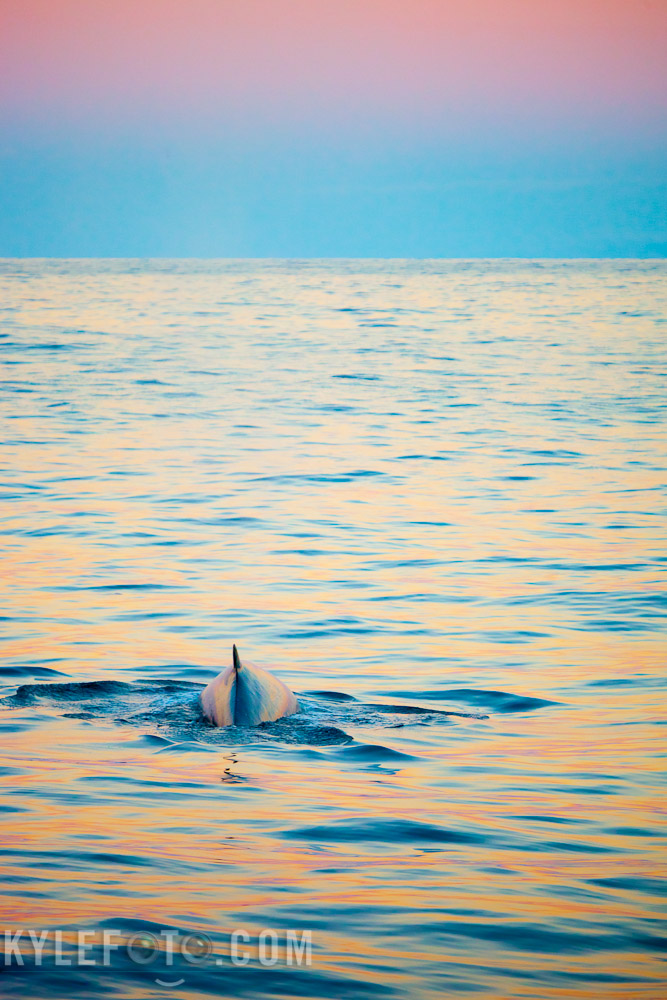
Glacier in the sun
Glacier in the sun Antarctica
It was an ultra windy day, too windy to do any landings to explore other areas. Luckily in the shelter of this ice shelf we were able to get our zodiacs out to explore this bit of area amidst the whipped up ocean. We still had to get out into the weather to get here, after being soaked from the surface of the water being carried by the gale, this little part of the ice shelf felt like a calm piece of heaven. Fine snow was being blasted off the glacier by the katabatic winds, giving the edges an etherial feel. You can see this fine dusting in the sun star, it was like a frozen mist.
Photographic Details: Those who have been following my photography know that I’m not afraid to shoot into the sun, something a lot of people have been taught not to do. And like my other sun shots I used an aperture of f16. This employs more aperture blades, and the more blades used, the more points you see in the sun star. The high image quality of proper RAW exposure and processing ensures that even the shadows have details, all with taking only a single exposure, an important skill to learn while in a moving boat.
For more antarctic photos check out my antarctic worlds gallery: http://www.kylefoto.com/galleries/antarctic-worlds/
The Skua, Lay down for your wildlife shots
The SkuaAn inquisitive animal is an intelligent one Gold harbour, South Georgia, Antarctic island.
The Skua is one of the most visible predators of penguins in the Antarctic, but also the most intelligent. I parent penguin will often chase after a skua to defend it's egg or chick, but unfortunately for the penguin, the Skua will work in teams. While the parent is distracted the other bird will come in, and they will get to feed. A penguin egg or a baby chick is a high reward for a Skua, I know it might be terrible to watch, but the skuas need to eat too (and their chicks are cute!).
Photographic details It was a joy to get a shot like this, it's times like these that carrying two cameras really comes in handy. I was watching the King Penguin colony, ready to shoot close up shots of penguin behaviour with my telephoto when the skua flies in right in front of me. I pulled out my other camera with my wide angle lens (16-35mm f2.8) and managed to get a few of these shots while the Skua pecked at my polariser. [lightbox id="2" size="small"] While this happened by accident, I maximised my chances of interacting with wildlife by laying down flat on the ground. In this position not only do I have the best viewpoint, I'm also not considered a threat and more of a curiosity to wildlife. Laying down I have had elephant seals snuggle me, penguins walk on me and of course, skuas investigating my lens. I also chose to keep a lot of the background and penguin colony in this shot, keeping this bird in full context of it's environment.
This is a blog post originally posted on http://www.kylefoto.com, If you like this be sure to check out the Antarctic Worlds gallery!
Put people in your landscapes
Put people in your landscapes Too often photographers go to great lengths to ensure there are no people in their photographs. This is often something difficult to do especially when on holidays and in touristy places.
Why not get the people to work with the landscape? How can adding a person or two improve a photograph? One of the most helpful things a human figure can do in a photograph is create a sense of scale
I was trudging along the shoreline in Antarctica, scattered with beached pieces of ice berg left by the waves and tides when I came upon this lovely scene. It was missing something, and I was alone, so I decided this was a good job for the 10 second timer on my camera. I stuffed my tripod into the snow, ran into the landscape as far as I could, and did my best to “look into the scene” in time for the shutter to release. Running back and forth was actually pretty good exercise, and pretty fun! I encourage you to try this environmental self portrait in your next sunset or interesting landscape shot, I’d love to see them if you do!
Technical facts: It’s important to note, on my particular lens (Canon 16-35 f2.8 L) and many other lenses, that when I stop down to f/16 I get a beautiful star shape out of bright objects like the sun. The number of aperture blades employed in the lens determines how many points you see in the star, even more reason to go with the “sunny f/16 “ rule!
Share if you like!
This is a blog post originally posted on http://www.kylefoto.com, if you like this be sure to check out the Antarctic Worlds Gallery here!
Porcelain Adélie
One sunny antarctic day was standing on a rock at the entrance to a penguin colony in Antarctica, watching them zip around underwater with joy. One of the coolest things is that they tend to jet out of the water onto land, but I don't think they look before they leap. Every so often one would fly out onto my rock only to be extremely surprised to see me standing there, immediately and frantically trying to back-flap their way into the water. This Adélie was particularly entertaining!

Luminous ice
This beautiful iceberg was grounded by the low tides in Antarctica outside Cuverville island. The water being so crystal clear and free of sediment that light travels down without reflecting much back making it appear black. In addition the bright overcast conditions and high reflectivity of the snow and ice forces me to let in less light in the camera, darkening the water down even more. It's this contrast that gives the image a sense of drama.
Lately I have been very active on Google+ and have found the community to be very engaging, for that reason I have been premiering a lot of my content on my page here first. So I feel compelled to post some extra info derived from conversations on this article as well.
Thomas Russ Arnestad asks: "I'm curious about one thing though, there are some grey/black spots/shaded in the blue ice; is this a result of pollution?"
I was very careful to keep those spots in there, as they aren't artificial (nor are they dust spots on the sensor). I'm delighted you noticed them because they tell a fantastic story about the formation of these icebergs. I think it's safe to say these icebergs are pretty much geological in origin, as all icebergs start off as glacial ice formed by the compaction of snow on the mountain slope. This ice slowly flows down the mountain, and in doing so it grinds away at the rock, creating gravel and silt and carving U shaped valleys in the mountain side. When some of these pieces of ice finally make it into the ocean, they may have picked up lots of debris and rocks, some can be extremely dirty, huge boulders can even be found in icebergs. You can even go diving in the antarctic and find large "erratics" deposited by rock carrying icebergs.
The older the ice, the more likely it is to be at the bottom of a glacier where there is an extreme amount of pressure, this pushes out air bubbles and causes the ice to become more translucent, and this in turn can make the ice bluer, hence the wonderful colours in this ice and the high amounts debris trapped inside.
Technical photo details: This was shot hand held while driving a zodiac (like the image atop) , then tonemapped in HDR software Photomatix. Later printed on metallic paper the colours really shine and shift, much like the ice does in real life! Approximate location here.
Antarctic underwater iceberg
Sometimes a little forethought turns a concept into reality, a brief making of this photo: Ever since I first found out I was really going to Antarctica, I’ve had this shot in mind. I didn’t know for sure that I would be presented the chance to do this but because the concept existed in my imaginary portfolio it was ever-present in my mind.
To prepare for this I made a small investment in an ewa-marine underwater housing, It’s essentially a waterproof bag that will fit anything roughly shaped like an SLR camera.
How it looks  Canon 10-22mm lens at 14mm (equivalent 22mm) ISO 200 shutter priority 1/125 of a second
Canon 10-22mm lens at 14mm (equivalent 22mm) ISO 200 shutter priority 1/125 of a second
Months later I was driving a zodiac boat outside the Lemaire channel in Antarctica, when this somewhat small piece of ice was floating by me. My imaginary photo flashed before me as I positioned the zodiac just right for the shot. I leaned over the side of the zodiac dipping my camera and lens half into the water. The camera is on shutter priority mode, so I don’t have to worry about managing any settings on my “camera-in-a-bag” in the -1°C water. This being on an ultra wide-angle lens I zoomed out to 14mm (full frame equivalent 22mm) which allowed me to capture a wide enough angle to encompass both the immediate foreground and the background. The underwater part of the image loses a lot of light compared to the above water portion, I had to significantly brighten the water with the original raw image. I expected to get this shot after nearly a hundred tries, but as luck had it this was about the 7th shot I took. Needless to say after I retrieved my camera and rinsed the salt water off the housing I was delighted with the results, and I hope you are too!
Deceptively cool
The Drake passage was was generous to us this time. With a tail wind and following seas we ended up with a 15% speed increase for nearly two days, and even made a stop to watch the Humpback whales. This is what allowed us our bonus day in Antarctica. Deception island, the place most guides don't like to go, because we always go there, however it hasn¹t lost it¹s touch on me. Part of the reason why is summed up in a lovely passage in the Lonely Planet guide for Antarctica:
"Because deception island is one of the most popular visitor sites, it¹s thought-provoking to learn that volcanologists consider it ³a restless caldera with considerable volcanic risk".
A sudden collapse of Deception¹s caldera could cause a major eruption, ³with potentially devastating effects on anyone on the island at the time² with escape from the land ³unlikely². The probability of the caldera collapsing, however is ³very low² and would probably be preceded by earthquakes for several days or weeks prior to an eruption. ³However, any eruptions can take place with relatively little immediate warning.² The plan also offers this helpful suggestion: ³if ships are present within Port Foster when an eruption occurs, they should depart the island immediately, ideally after uplifting all people ashore.² ideally indeed.²
We enter Neptune's bellows (which I have to pronounce "NEPTUUUUUNES BELLOWWWWWWWWWS" for dramatic effect) to get inside the caldera of this toilet bowl shaped island, which is a tight squeeze for the ship.
We wandered around the black volcanic sand, and got to watch the sky turn orange since this is a rare late night excursion. I took a walk up to Neptune's window (just underneath neptune's nipple) and on the beach we discovered these really fascinating colonizing organisms throbbing on the shore that to me looked like some kind of egg casings. Turns out they were salps, filter feeding organisms that I certainly have to do more research on. They looked clearer than any crystal I've seen with a bright red nucleus, and twitched slowly.
The sun sat but the twilight stayed, this being the day after the summer solstice it never gets completely dark. The ship beckoned, glowing with warmth as christmas draws near.
I leap onto the ship with glee because that night was the time to decorate the clipper bar with christmas cheer. The Tree stood bare, begging to be decorated, mulled wine, gingerbread cookies and a warm fire (a dvd of a fire place) greeted us. I had prepared the DVD and and loads of christmas music months in advance in anticipation of this. I didn¹t last long, I have a full day of Antarctica ahead of me, sleep is welcome.
The Day in Onomatopoeia
Half Moon Island & Barrientos Island Anchor: gahgun dadun dadun dadun.. clonk
Zodiac: Bvvvvvvvvvvvv
People: Wheeeeeeeee! tromp tromp
Gentoo Penguins: gaaaaa-hee! gaaaaa-hee! gaaaaa-hee! Gaaaaaaaaaaa...
Skua: Eeraaaa raaa raaa eeraaa!
People: click click click beep oooooh!
Chinstrap Penguin: Chachacheeecharararara
Weddell Seal: Weeeeeeeeoombooooomp..boomp...boomp click booomp
Wind: Whooooooooooshshahahahashoomshoom
Elephant Seal: Braaaaaaaap. ppbt..pbbt...burp...pfffffft argh argh argh ppbpbt!
Leopard Seal: ......
People: tromp tromp, splish eeee!
Zodiac: Bvvvvvvvv-splash-vvvvvv
Humpback Whale: Pffffwah....pffwah...shloomp
People: shooka shooka shooka woow!
Hot chocolate: shlurp shlurp Mmmmmmmm


